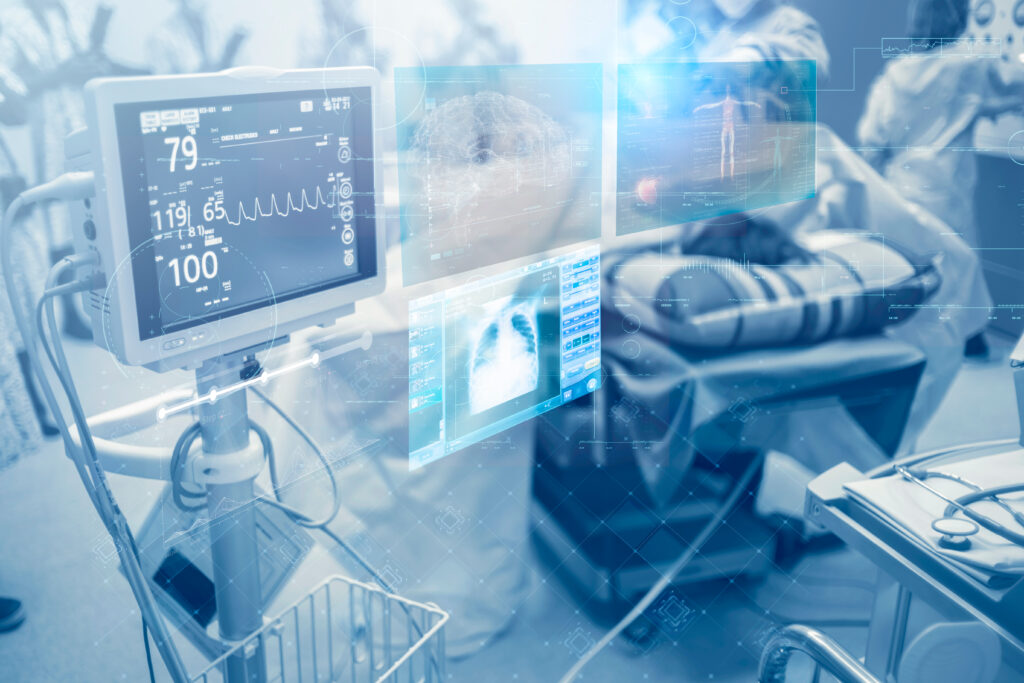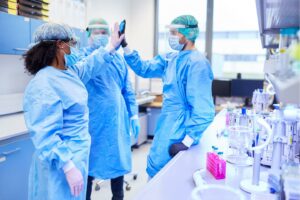Medical device equipment is a large family of devices. It refers to any apparatus, instrument, machine, implant, or other similar device that is intended for use in diagnosing, treating, or preventing a medical condition or disease. It can range from simple tools like thermometers and stethoscopes to complex machines like MRI scanners and robotic surgical systems.
A medical device equipment is designed to be used by healthcare professionals or patients under the direction of healthcare professionals. They are subject to rigorous testing, regulatory approval, and ongoing monitoring to ensure their safety and effectiveness. It plays a crucial role in modern healthcare, helping to diagnose and treat a wide range of medical conditions and improve patient outcomes

What challenges to overcome?
When it comes to developing innovative medical device equipment, many parameters must be considered to approach, optimize and secure your product development. If we intend to summarize difficulties to face, several development challenges that can be grouped into four categories:
Regulatory Challenges: Medical devices must meet strict regulatory requirements to ensure their safety and efficacy. Obtaining regulatory approval is a time-consuming and expensive process that can be a significant barrier to innovation. Compliance with regulations such as FDA 510(k) or premarket approval (PMA) require extensive testing, clinical trials, and documentation, making it difficult for smaller companies to compete.
Technical Challenges: Medical devices must be designed and engineered to meet specific clinical needs while being safe and reliable. Developing new technologies that meet these requirements can be challenging, and the high level of technical expertise required can be a barrier to entry for new companies.
Economic Challenges: Medical devices must be cost-effective to be widely adopted, yet research and development costs can be high. Additionally, reimbursement policies can be complex and vary by region, making it difficult for companies to determine the potential market for their products and generate revenue.
Clinical Challenges: Medical devices must be tested in clinical settings to demonstrate their effectiveness and safety. Clinical trials can be costly and time-consuming, and there may be ethical considerations when conducting trials on human subjects. Furthermore, clinical trials may require significant expertise in the medical field, which may be lacking in some companies.
Which steps to successfully develop a medical device equipment ?
A pragmatical but successfully proven method to develop a healthcare innovation can be applied to medical device equipment. Optimizing the development of your medical device equipment will then involve several key steps:
- Define the problem: Start by clearly defining the problem that your medical device equipment aims to solve. This should include understanding the needs of the users, the market demand, and the regulatory requirements.
- Conduct a thorough market research: Before designing your medical device equipment, it is essential to conduct a comprehensive market research to identify the existing products, their features, and gaps in the market. This will help you design a device that meets the needs of the users and stands out in the market.
- Involve end-users in the design process: Engage end-users such as clinicians, patients, and healthcare professionals early in the design process. This can help ensure that the device is intuitive to use and meets the needs of the users.
- Implement a rigorous development process: Develop a development process that ensures quality and compliance with regulatory requirements. This includes testing the device extensively to ensure that it is safe, effective, and meets regulatory requirements.
- Incorporate feedback: Gather feedback from stakeholders throughout the development process and use this feedback to refine the device design.
- Plan for manufacturing and distribution: Plan for the manufacturing and distribution of your medical device equipment early in the development process to ensure that the device can be manufactured cost-effectively and can be distributed efficiently.
- Continuously monitor and improve: Continuously monitor the performance of your device after it has been released to the market and use this data to make improvements and refinements to the device over time.
By following these steps, you can optimize the development of your medical device equipment, ensuring that it meets the needs of the users, complies with regulatory requirements, and stands out in the market.
A common mistake in medical device equipment development is to undermine the skills and expertise required for the success of your product development
Which skills for your medical device equipment development?
A common mistake in medical device equipment development is to undermine the skills and expertise required for the success of your product development. Here are the key profiles of an efficient development team you must rapidly gather around you:
Technical experts: Technical expertise is the foundation of medical device development. Engineers and designers should have a deep understanding of the technology behind the medical device, including the materials used, the design, and the manufacturing process. The ability to create a comprehensive design that meets regulatory requirements, safety standards, and user needs is crucial.
Regulatory Compliance: Developing a medical device involves navigating complex regulatory pathways. The regulatory landscape varies from country to country, and it is constantly evolving. Medical device engineers and designers must be familiar with the regulatory requirements of the countries in which they are working.
Project Management: Effective project management is critical to the success of medical device development. Project managers must be able to oversee the development process from concept to commercialization, ensuring that the project is completed on time and within budget.
Quality Control: Medical devices must meet stringent quality control standards to ensure they are safe and effective. Quality control professionals must ensure that the design and manufacturing process meets the required quality standards.
Risk Management: Risk management is an essential part of medical device development. Medical devices must be safe for patients, and any potential risks must be identified and mitigated. Engineers and designers must be able to assess the risks associated with the device and develop strategies to minimize those risks.
By building a team with a diverse set of skills, medical device equipment manufacturers will then be able to achieve their product development and create safe, effective, and innovative devices that improve the lives of patients


